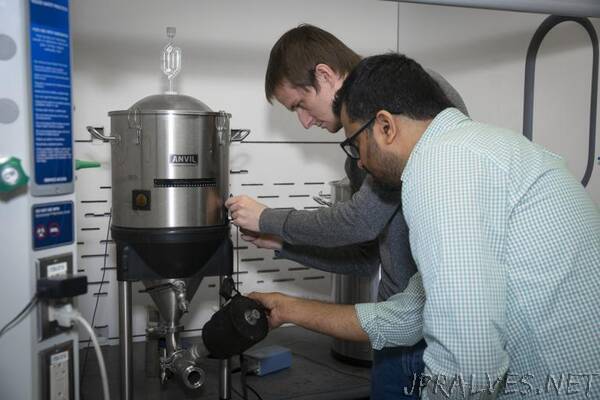
“As beer lovers sip their favorite IPAs on a weekend or after a long day’s work, they might be unaware — and who can blame them? — of the complexity of the brewing process and all the things that can go wrong in getting that tasty beverage from the recipe to the restaurant table.
Especially in many of the more than 8,800 craft breweries in the United States, the art of brewing is still very much a manual process, relying on sampling, testing and tinkering.
As a scientist on an acoustic-science research team at Los Alamos National Laboratory, I have long been interested in acoustic sensor technology. Developments in this science apply to the oil and gas sectors and other industries, but we saw the potential in the brewing industry. Visiting craft breweries in the Denver area last year, as well as canvassing many of the breweries here in New Mexico, we heard about their challenges and assessed the potential for acoustic-sensor technology in this fast-growing industry that nonetheless has complex technical challenges. It looked like a good fit of technology to a tasty application.
Brewing is a multi-step process. In the critical fermentation stage, yeast is added to a mixture of wort, which is an infusion of malt or other grains, and hops (a so-called slurry) within a stainless-steel vat. Inside the vat, yeast sets to work converting sugars in the wort to alcohol and carbon dioxide. Brewers often check progress manually by draining off the product to sample it.
As we talked to brew masters, they noted that monitoring fermentation was important for quality and efficiency. With batches sometimes containing hundreds of gallons in larger industrial operations, the fermentation stage can take weeks. That’s plenty of time for something to go wrong — at the expense of the batch, the labor to produce and monitor the product and the availability of the equipment occupied by the beer-in-progress.
With a window into the problem, we returned to the lab and we embarked on developing a solution. Brewing beer proved to be a novelty at Los Alamos, but the physics of materials is a longstanding specialty. So in our unique pilot brewing operation, we developed the SoniView acoustic sensor system.
SoniView relies on a couple key pieces of technology. Vibrations from a transducer attached to the front, outer side of the vat send sound waves into the medium inside the tank. A sensor on the back, outer side of the vat picks up the vibration and converts it to an electrical signal. Fed into an oscilloscope and a computer, the system provides visualizations and data on the progress of fermentation.
Knowing the distance from one side of the vat to the other, the “time of flight” it takes the sound wave to travel from the transducer to the back sensor helps determine the speed of sound through the liquid. That speed constantly changes as the beer ferments and the relative amounts of sugars, alcohol and other components change. Additionally, when the slurry is actively fermenting, the sound traveling through the liquid will be weaker because so much carbon dioxide is being produced. Carbon dioxide production drops off the longer the wort ferments, which is picked up by the acoustic sensors. Eventually, the yeast dies off and drop to the bottom of the vat as trub, a layer of sediment. The sensors provide continuous, real-time insight into the entire process.
Traditional brewing means periodically checking the fermentation by draining some product out during the process. SoniView’s monitoring capabilities provide the lynchpin for more efficient — and profitable — processes. Now data can be acquired in real time, so labor that might otherwise be spent manually checking on fermentation is freed up for other tasks. SoniView also quickly and accurately determines the transition from yeast slurry to beer when dumping the yeast and closes the dump valve. This is especially important for larger breweries because slurry may require expensive handling and disposal. It also saves beer during the dump process.
With this key technology monitoring arguably the most critical stage in brewing, each batch comes out according to plan: ready for filtering, packaging and eventual consumption. Our experimental efforts also create a database of calculations that can provide useful information for brew masters as they prepare and perfect their batches.
Getting this technology out of the laboratory and into businesses is a key goal, facilitated by the Feynman Center for Innovation at Los Alamos, which licenses technology to partners in the private sector. We’ve also partnered on a New Mexico Small Business Assistance project, teaming up with a Santa Fe area brewery to test the technology in a scaled-up, commercial setting.
That outreach means that New Mexico businesses might have a science-driven complement to the art of brewing, and an advantage in creating delicious beer that customers can enjoy — every batch, and every sip, just right.”
